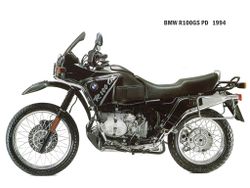Difference between revisions of "BMW R100GS"
| Line 1: | Line 1: | ||
Despite their reputation as superb touring bikes, [[BMW]]s have always been involved in off-mad competition. Since 1929 BMW has participated in the International Six Days' Trial and been involved in [[enduro]] racing for over half a century, | |||
==Four Victories in Paris-Dakar== | |||
After some private entries had demonstrated the efficacy of big engines in the wide-open spaces, the BMW factory participated in the classic Paris-Dakar rally usually dominated by Japanese singles. Victories soon followed: in 1981 and 1983 for Hubert Auriol, followed by Gaston Rahier in 1984-85. | |||
==Enter the Paralever== | |||
It was a dramatic lesson for the Japanese and Italians. Profiting from this show of strength, in 1985 BMW launched the [[BMW R80GS|R80GS]]. (GS is for "Gelande Sport" -"cross-country sport.") It was the biggest trail bike of its day. The R80GS became the R100GS in 1988, with the addition of a major innovation: Paralever. The single-arm rear suspension of R80GS received an upper arm and a reaction bar, creating a deformable girder fork. "Freezing" of the rear suspension due to the action of the driveshaft during acceleration was suppressed. | |||
The R100GS, styled by Target Design, was sidelined in 1983 by a "Paris-Dakar" version equipped with an engine shield, a "cowcatcher" and a full fairing. Ironically, BMW long ago pulled out of African rallies under extreme pressure from the powerful "green" lobby that exists in Germany. | |||
==1994== | ==1994== | ||
[[Image:1994-BMW-R100GS-PD.jpg|left|thumb|1994 BMW R100GS PD]] | [[Image:1994-BMW-R100GS-PD.jpg|left|thumb|1994 BMW R100GS PD]] | ||
Revision as of 21:16, 18 March 2007
Despite their reputation as superb touring bikes, BMWs have always been involved in off-mad competition. Since 1929 BMW has participated in the International Six Days' Trial and been involved in enduro racing for over half a century,
Four Victories in Paris-Dakar
After some private entries had demonstrated the efficacy of big engines in the wide-open spaces, the BMW factory participated in the classic Paris-Dakar rally usually dominated by Japanese singles. Victories soon followed: in 1981 and 1983 for Hubert Auriol, followed by Gaston Rahier in 1984-85.
Enter the Paralever
It was a dramatic lesson for the Japanese and Italians. Profiting from this show of strength, in 1985 BMW launched the R80GS. (GS is for "Gelande Sport" -"cross-country sport.") It was the biggest trail bike of its day. The R80GS became the R100GS in 1988, with the addition of a major innovation: Paralever. The single-arm rear suspension of R80GS received an upper arm and a reaction bar, creating a deformable girder fork. "Freezing" of the rear suspension due to the action of the driveshaft during acceleration was suppressed.
The R100GS, styled by Target Design, was sidelined in 1983 by a "Paris-Dakar" version equipped with an engine shield, a "cowcatcher" and a full fairing. Ironically, BMW long ago pulled out of African rallies under extreme pressure from the powerful "green" lobby that exists in Germany.
1994
- Spark Plug: NGK BP6ES
